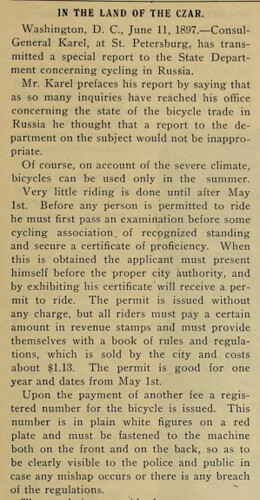The comic actor and performer Jonathan Winters just passed away - I grew up thinking he was terribly funny, although sometimes puzzling. I found myself looking at some of his performances on YouTube and in particular his contributions to the epic (if only in length at 161 minutes) "pursuit" comedy film, It's a Mad, Mad, Mad, Mad World.
At 2:22 Winters retrieves the bicycle he has thrown away and eventually uses it to set off in pursuit, after first stomping on it
To my mind, one scene unintentionally makes a statement about the attitude of most Americans towards bicycles at this time, in the mid-60s. Winters' character, Lennie Pike, is determined to continue despite being reduced to a bicycle (and a child's bicycle at that). He manages to get a ride with another character by Phil Silvers and immediately tosses the bicycle away, with evident pleasure. The Phil Silvers character however drives off without him, leaving Pike (Winters) to retrieve the bicycle and continue using it. First, however, he stomps on it several times. Then, left with no alternative, he continues with the bicycle. A bicycle in 1963 for transportation? The last resort.
Completely separate from that, Winters was the best thing about this movie.
When the first diamond frame bicycles became popular in the 1890s they were often called "wheels" - the national cycling association was called the "League of American Wheelmen." We have moved from "wheels" to "bikes," but the bicycles have remained remarkably the same over more than 100 years - elegant in their efficiency and simplicity. And many of the issues that we think are new? They were around then too.
Saturday, April 13, 2013
1896 Bicycle Built for Seven - the "Sept"
An article describing the (claimed) only seven seat bicycle of the day in Referee & Cycle Trade issue of April 23, 1896. At the time three and four seat bicycles were general used to "pace" riders who would draft behind to set certain categories of bicycle speed records and in certain races - to have a seven seat version would likely not be faster, so this is something of a publicity stunt, I think.
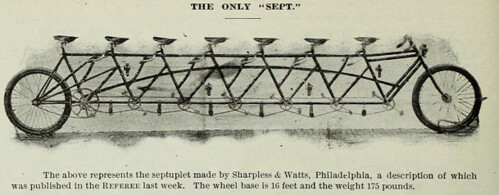
A photograph of the "Sept" from the next issue of Referee & Cycle Trade of April 30, 1896
There are modern seven-seat bicycles, but the best known (see below) is a novelty item - in a number of cities you can rent one for your company or organization to use for "team building" exercises, for example.
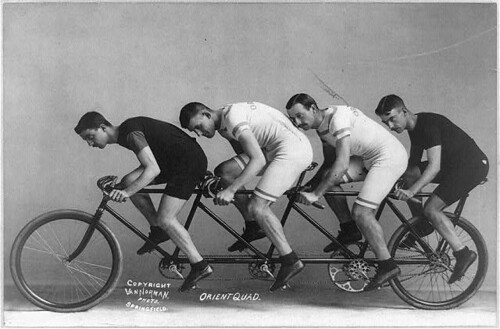
A more typical multiseat bicycle of this period used to "pace" racers
THE ONLY "SEPT."
- - -
Sharpless & Watts Are Its Makers, and It Is a Marvel of Constructive Ingenuity.
- - -
Philadelphia, April 21.—There is now on exhibition at the extensive bicycle factory of Sharpless & Watts, at 1520-22 Sansom street, that Goliath among bicycles—an account of the building of which appeared in these columns some weeks ago—the only septuplet in the world. The frame is practically seven ordinary single diamonds firmly joined together, with all the joints securely brazed, forming a sort of truss bridge between the contact points of the front and rear tires—a wheel base of 16 feet. This will give some idea as to the length of the monster.
It is constructed throughout of l 1/4-inch tubing, and, although no special fittings were required in its construction, David Watts, a member of the firm, is authority for the statement that the toy is worth a "cool thousand." As must be imagined, the strain on the front forks will be immense, but Mr. Watts has provided for this by constructing them of inch tubing, into which 7/8-inch tool steel is driven, insuring the necessary rigidity. This feature of providing additional strength at points of greatest strain is a peculiarity of the entire construction.
An innovation in a strengthening way, which is necessitated by the extreme length of the structure and the immense load it will be called upon to bear, is the introduction of long arches of angle steel, extending on either side of the frame from the front to the rear diamond; at every point of contact these angle steels are firmly brazed. This is also an idea of Mr. Watts', and insures a rigidity which he says is noticeably lacking in pacemaking machines of a similar character.
To assist the front man to steer—for it is a single steerer—an ingenious device of springs on either side of the front handlebar has been utilized which will take much of the strain off him to whom is entrusted that important function.

A photograph of the "Sept" from the next issue of Referee & Cycle Trade of April 30, 1896
Back to the last man the tread is 5 1/2 inches; beyond that point to the rear sprocket it is a half inch more. The whee's are 30 inches in diameter, and the spokes are a little less than an eighth of an inch in thickness and fastened to barrel hubs measuring 2 1/2 inches in diameter in the center. With forty teeth in the large sprocket and ten in the rear the gear is 120 inches. The chains throughout are the best Perry Humber 1/4 inch. The 2 1/2-inch tires, which were specially made by Morgan & Wright, are a half-inch in thickness. The weight of the machine, "all on," is in the neighborhood of 175 pounds.
Mr. Watts, on being questioned as to his idea in building the mammoth -wheel, said, in substance: "We built the 'sept' merely to announce to the cycling world at home and abroad that right here in Philadelphia there is a plant which has facilities for constructing wheels of any pattern or dimensions. Of course, we intend to exhibit, it, and it will no doubt prove a good advertisement in its way. Do I think it can be safely managed at high speed on the track? I most certainly do—provided the track is a properly constructed one; and if we can get seven good men on it, and a track that isn't too small and is properly banked, the records will have to come our way. No; we don't intend to race the Atlantic City 78-mile-an-hour express, although I haven't the slightest doubt that we could hold our own against that world-beater for a short distance. I hope to see our pet on the track before long, when the local public will have an opportunity of sizing it up."
There are modern seven-seat bicycles, but the best known (see below) is a novelty item - in a number of cities you can rent one for your company or organization to use for "team building" exercises, for example.

A more typical multiseat bicycle of this period used to "pace" racers
Thursday, April 11, 2013
Idyllic Country Bicycle Ride - Monarch Cycle Co. Ad 1896
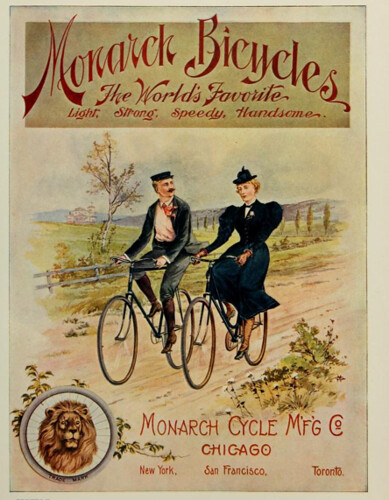
Full page color ad for Monarch bicycles in The Referee and Cycle Trade Journal issue for January 23, 1896.
According to a short online biography of the founder, John William Kiser, the Monarch Cycle Manufacturing Company was active during much of the 1890s but became part of the "bicycle trust" shortly before an economic crash that (as I understand it) seems to be credited with much of the fall in bicycle sales around that time.
Here is an earlier post with another color ad from Monarch showing bicycles in Egypt, apparently navigating through sand. This journal (Referee and Cycle Trade Journal) must have been pleased to have their full page color ads from time to time since presumably they got more income from them. Color ads in publications like this were rare - most issues that I have looked at do not have any.
Saturday, April 6, 2013
The State of Cycling in Russia, June 1897
Американский обзор езды на велосипеде в России 1897
From The Wheel and Cycling Trade Review - an extended overview of cycling in Russia, primarily with an eye to business opportunities selling American bicycles in Russia. What is the market? Who is riding? Why? And so on. The list of regulations governing cycling in Russia are, to say the least, daunting. The Czar's empire took second to no country in this area.
I have reproduced the text of the entire article here as well as including an image of part of the article as it appeared in the original publication (on rather brown paper ~).
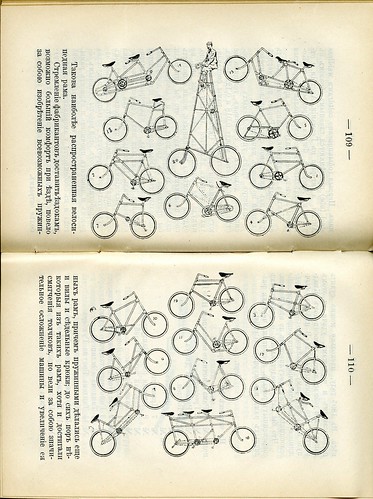
Examples of bicycles in an 1895 Russian book
Another earlier 1895 American look at Russian cycling.
From The Wheel and Cycling Trade Review - an extended overview of cycling in Russia, primarily with an eye to business opportunities selling American bicycles in Russia. What is the market? Who is riding? Why? And so on. The list of regulations governing cycling in Russia are, to say the least, daunting. The Czar's empire took second to no country in this area.
I have reproduced the text of the entire article here as well as including an image of part of the article as it appeared in the original publication (on rather brown paper ~).
In the Land of the Czar
Washington, D. C, June 11, 1897. Consul-General Karel, at St. Petersburg, has transmitted a special report to the State Department concerning cycling in Russia. Mr. Karel prefaces his report by saying that as so many inquiries have reached his office concerning the state of the bicycle trade in Russia he thought that a report to the department on the subject would not be inappropriate.
Of course, on account of the severe climate, bicycles can be used only in the summer.
Very little riding is done until after May 1st. Before any person is permitted to ride he must first pass an examination before some cycling association, of recognised standing and secure a certificate of proficiency. When this is obtained the applicant must present himself before the proper city authority, and by exhibiting his certificate will receive a permit to ride. The permit is issued without any charge, but all riders must pay a certain amount in revenue stamps and must provide themselves with a book of rules and regulations, which is sold by the city and costs about $1.13. The permit is good for one year and dates from May 1st.
Upon the payment of another fee a registered number for the bicycle is issued. This number is in plain white figures on a red plate and must be fastened to the machine both on the front and on the back, so as to be clearly visible to the police and public in case any mishap occurs or there is any breach of the regulations.
The regulations provide that:
1. Only "low" wheels, or safeties, shall be ridden, and that each rider shall always carry his permit guaranteeing proficiency. Before the permit is issued the rider must file with the City Governor a photograph of himself, to be used in cases of trouble.
2. Every bicycle must be furnished with a bell and at night with a light, and the numbers spoken of must be in sight; that on the front, so as to be seen from either side of the wheel and that on the back, from the rear or the front.
3. Every rider must carry with him at all times, and must show to the police when required, his book of regulations.
4. Fast riding is prohibited.
6. All riders meeting pedestrians, vehicles, or other riders must keep to the right.
6. When passing pedestrians or vehicles going in the same direction riders must keep to the left.
7. When approaching corners or when near pedestrians riders must ring their bells, but bells must not be rung needlessly.
8. If horses take fright riders must get off their wheels and lead them, and when in crowds must do the same.
9. Wheelmen may not ride abreast, and where there is a party of them there must be at least fourteen feet of space between the riders.
10. Riders must not ride or lead their wheels on the sidewalk,
11. Riding in bicycle costume without a coat is prohibited.
12. Riding on certain streets named by the City Governor is not permitted.
13. Any violation of any of these regulations causes the rider to forfeit his permitand it cannot be renewed for another year.
Previous to February 1st, 1897, women were prohibited from using the wheel, but now the restriction has been removed. There are in St. Petersburg four bicycle clubs and in the suburbs three more. In all there are about 7,000 cyclists in the Capital.
Wheels are imported in large numbers, principally from Germany, England and the United States, the proportion being in the order named.
There are five factories in Russia which manufacture bicycles, two being in St. Petersburg, one in Moscow, one in Warsaw, and one in Riga. There are a number of smaller concerns hardly large enough to be called factories where wheel parts after being imported are assembled.
Two of the factories spoken of are English, that at Warsaw being the establishment of the Singer Cycle Co:, and that at Moscow of the Humber Works.
Wheels made in Russia sell for from $42 to $67, the German wheels from $77 to $92.50, the English wheels from $82 to $128.50, and the American wheels from $103 to $128.50. Although the American wheels are the most expensive, they are preferred on account of their superior finish and their greater durability. Only the high-grade American wheels have been imported.
The whole number of wheels imported in 1896 was 10,609. The duty on finished wheels is about $9.26 per wheel; on unfinished wheels in parts, is about $6.18 each.

Examples of bicycles in an 1895 Russian book
Another earlier 1895 American look at Russian cycling.
Tuesday, April 2, 2013
The Folding Bike Idea - of 1896
In the The Referee and Cycle Trade Journal issue for April 9, 1896 there are a number of pages with smaller ads for different cycling related products and smaller companies selling bikes.
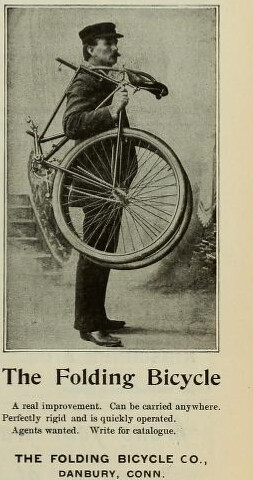
A folding bike for the 19th century
There are not all that many truly new ideas in basic bicycle design.

A folding bike for the 19th century
There are not all that many truly new ideas in basic bicycle design.
Saturday, March 30, 2013
Easter Cycling Events - 1897
In looking at American newspapers from the late 1890s, I found these two illustrations from the St Paul Globe and the Washington Times looking at cycling and Easter 1897.
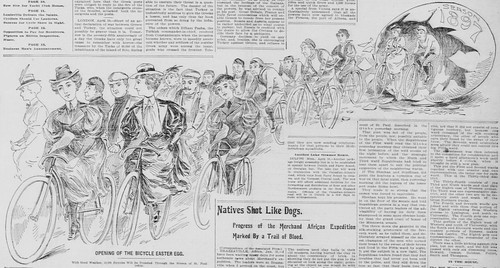
An amusing illustration showing a variety of cyclists who would riding in an annual Easter cycling event
With an expectation that as many as 10,000 would be riding if there was good weather - that's a pretty high number. At the "opening of the Bicycle Easter Egg." From the St. Paul Globe, April 11, 1897.

In Washington the expectation was that "thousands" would be out riding - again, depending on the weather
From the Washington Times, April 18. 1897

An amusing illustration showing a variety of cyclists who would riding in an annual Easter cycling event
With an expectation that as many as 10,000 would be riding if there was good weather - that's a pretty high number. At the "opening of the Bicycle Easter Egg." From the St. Paul Globe, April 11, 1897.

In Washington the expectation was that "thousands" would be out riding - again, depending on the weather
From the Washington Times, April 18. 1897
Friday, March 29, 2013
Helmets & Choosing to Ride a Bike
The National Bureau of Economic Research, a think tank, has a new report about helmet usage and safety - "Effects of Bicycle Helmet Laws on Children's Injuries." Here is a summary:

My daughter some years ago, learning to ride and wearing a helmet - of course
While a rather indirect statement, the "effects" that they think "policymakers" (ie, legislators, mostly in state legislatures) should consider would be whether helmet laws are useful overall if the result is as much to reduce bike ridership as the means by which injuries are reduced. It seems hard to imagine anyone seriously advocating eliminating already established helmet laws for children (defined in a wide variety of ways, as the report notes) or opposing new ones, but it certainly seems worth looking at a study like this when considering mandatory helmet laws for adults.
Cycling is popular among children, but results in thousands of injuries annually. In recent years, many states and localities have enacted bicycle helmet laws. We examine direct and indirect effects of these laws on injuries. Using hospital-level panel data and triple difference models, we find helmet laws are associated with reductions in bicycle-related head injuries among children. However, laws also are associated with decreases in non-head cycling injuries, as well as increases in head injuries from other wheeled sports. Thus, the observed reduction in bicycle-related head injuries may be due to reductions in bicycle riding induced by the laws.The report is interesting and some of what it says is of more general interest than just helmet usage by children. They aren't impressed with the rigor of previously done studies looking at helmet use by children (there are only two) and they take care to compensate for those errors. Their results suggest that the main reason why helmet laws reduce head injuries is more about reducing the amount of bicycling than by better outcomes from accidents thanks to wearing helmets. The last paragraph of the report concludes:
The findings from this paper indicate that while bicycle helmet laws are widespread and thought to be effective, the net effect of these laws on health outcomes is actually not straightforward. It is clear that there are offsetting behaviors and unintended consequences of these laws, and these effects need to be considered by policymakers.

My daughter some years ago, learning to ride and wearing a helmet - of course
While a rather indirect statement, the "effects" that they think "policymakers" (ie, legislators, mostly in state legislatures) should consider would be whether helmet laws are useful overall if the result is as much to reduce bike ridership as the means by which injuries are reduced. It seems hard to imagine anyone seriously advocating eliminating already established helmet laws for children (defined in a wide variety of ways, as the report notes) or opposing new ones, but it certainly seems worth looking at a study like this when considering mandatory helmet laws for adults.
Subscribe to:
Posts (Atom)
